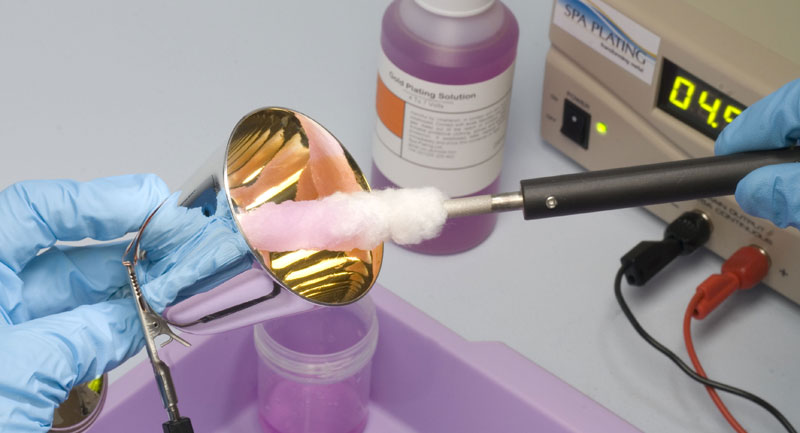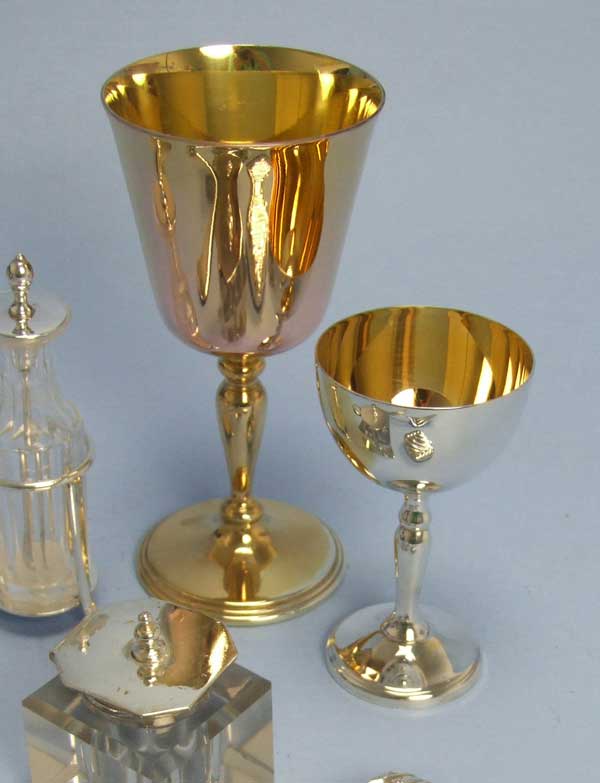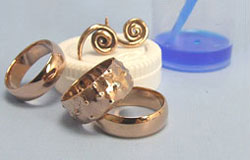Gold brush plating - an introduction
Gold brush plating
Gold is by far the most popular metal to plate using the brush plating technique and spectacular results can be obtained on a wide range of surfaces, both metal and non-metal. Gold brush plating is ideal for small batch plating, plating in situ where removing the item to be plated isn't an option (for example bath taps and door handles), very large objects that would be difficult to fit in a plating tank and selective gold plating of larger objects such as goblets and plating on to non-conductice materials such as plastic or glass.
We sell a wide selection of different kinds of gold brush plating solutions for different applications, so you should find just the right kind of brush plating solution you need from our online shop.

Gold is an easy metal to plate with
Gold is one of the easiest metals to electroplate, mainly due to the fact that it is almost inert; that is to say, it does not react with other chemicals. For this reason it forms an excellent undercoat for plating onto passive metals, for example high chromium-nickel containing alloys such as stainless steel.

A selection of antiques that have been up-cycled with our Gold Brush Plating Solution. Some of these items have been selectively gold plated, which is much easier with the brush plating technique.
Rose gold, green gold, white gold...
Our K-Gold plating solution can be mixed with our specially designed Coloured Metal Mixers to produce a wide range of different coloured gold finishes. This flexibility means you can match all the most popular shades of gold found in bathrooms by mixing our KGold solution with our gold mixers. Rose gold is also easy to create using the same method, making it possible to match many of the commonly found shades of gold in precious jewellery.
The technique of creating your own bespoke shade of gold using our gold mixers is inexpensive as you don’t need to keep bulk supplies of all the different shades and colours of gold and you only mix what you need to do the job.

How to be economical with your gold solution
Gold brush plating solution can be mixed with our Thickener to form a gel. The great advantage of this is that the plating solution stays on the work and doesn’t run off. This not only helps to build up a thicker layer of plate faster, but also cuts down on wastage of your gold plating solution.
NB – all of our other plating solutions can also be mixed with Thickener, so you can use the same Thickener for most of our other brush plating solutions.
Gold Plating Trouble Shooting
What to do if you experience any problems with your gold brush plating;
| Type of problem | Possible reason | What to do | ||
|---|---|---|---|---|
| No plating taking place | Incomplete electrical circuit. Surface not clean enough. Surface inactive. |
Check all electrical connections and clean if necessary. Make sure the swab is fully soaked in solution. Hand polish with MPU, clean and re-plate. Check that surface is conductive with one of our Conductivity Testers. |
||
| When using Coloured Metal Mixers, gold is plating but the wrong shade. | Incorrect mixing. Solution is contaminated. |
Refer to the gold mixing table. Make sure the swab is clean and well rinsed with deionised water before plating. Don’t pour used solution back into its storage bottle. |
||
| Plating flaking off when plating nickel and nickel containing alloys. |
|
|
||
| Plate wears off very quickly on corners/edges of work. |
Voltage too high. | Reduce voltage to 5-6 volts for plating corners/edges. | ||
| Dull patches of plate appearing. | Surface inactive. Surface of work insufficiently polished. |
Clean with MPU, making sure you cover all areas. Re-polish. |
||
| Plate peeling/no plating around hinges on hinged articles such as boxes. | Polishing compounds and preparation chemicals still present on surface of work. Contamination from oil oozing from hinges. |
Dry your work thoroughly and clean with a little lighter fuel by squirting it directly into the hinge or onto the work’s surface. Allow the fluid to evaporate, then re-plate. |
2 responses to “Gold brush plating – an introduction and troubleshooting”
Leave a Reply
You must be logged in to post a comment.

Hiya, I gold plate nickel fishing spinner blades but struggle with the runny liquid and the floppy sponge tips. Wiuld be a great time saver to drip a whole string(wire) of them in a bath but looking at you site I guess the thicknet and the tips that look like lambs wool might do? I only make a few a week to order so cant go into it big time. All suggestions will be gratefully recieved and maybe you could put together a kit of basic essentials for me? Steve Homewood Facebook SJH Fishing Tackle
No problem with that and no need to put a swab on if you’re plating in a beaker.
Simply put the positive electrode in a beaker (without the swab on) then put your spinner blade(s) in either move the spinner plates or electrode to provide agitation.
If they go dark or black, reduce the voltage until they come out gold.
Either that or use our online gold tank plating calculator to estimate times and amps and cost:
https://www.goldn.co.uk/gold-tank-plating-calculator